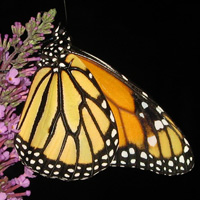Welcome back to our monthly blog which this month is dedicated to the famous Monarch butterfly. Despite a long PR campaign to save its habitat, it is now on the endangered list.
The Monarch is one of only three butterflies in the milkweed butterfly family (Danaidae) in North America. It is a very large butterfly that can grow to be 4.9 inches wide. The Monarch has a distinctive flight pattern defined by vigorous flapping followed by a long glide pattern. It is orange in color with a white spotted black margin along its entire wing and a black veined orange field within.
It lays its white eggs on hostplants in the milkweed family, which turn into brightly yellow, black and white ringed caterpillars. The caterpillars absorb a toxin from the milkweed they eat which makes them unattractive to predators.
What makes the Monarch so special though is its migration pattern. In September it flies south from the Northeastern US and Canada through the Florida panhandle, across the gulf, or through southern Texas to Michoacan, Mexico where it arrives in November.
There they form multiple colonies of more than 100.000 butterflies each to spend the winter living of stored fat until it is time to head north again in March. They then fly back to eastern Mexico or the southern US, lay their eggs and die.
The next generation continues north in April and May to the mid US where they repeat the process. The third generation then continues to the northern US and Canada. In September they make the same 2500-mile journey in the opposite direction. What of course makes this so remarkable is that none of these generations ever make the entire trip and still know exactly where to go.
We can help the Monarch here in Florida not only by planting milkweed too lay their eggs on but also by making sure we cut that milkweed back in the fall. If you have planted the preferred native milkweeds, such as sandhill or swamp milkweed, they may die back by themselves. The tropical milkweed we mostly find in commercial nurseries however will continue to grow and bloom in the fall, encouraging the Monarch to hang around and lay their eggs, thereby killing the next generation in our too low winter temperatures.
Join us next month for the last blog of the year when we pull all the info together, so we know how to do our bit to help butterflies survive our changing times.
For additional information please visit: https://gardeningsolutions.ifas.ufl.edu/design/types-of-gardens/butterflygardens.
html
Source: UF/IFAS Pest Alert
Note: All images and contents are the property of UF/IFAS.



